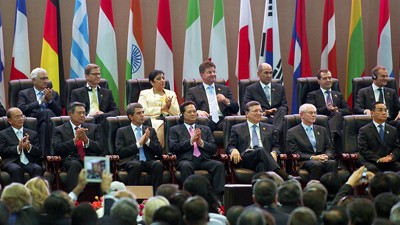(VOVworld) – The ninth Asia – Europe Meeting (ASEM) in Vientiane took place with the world reeling from economic crisis, troubling climate change, food insecurity, and exploding religious conflicts. Consequently, the conference sought cooperation and dialogue to find a path to peace, stability, economic recovery, and solutions to global challenges. VOV’s editor Anh Huyen reports…
 |
| Photo: VGP |
The two continents' meeting to reach a consensus about common goals is a positive signal. This is not the first time ASEM has focused on economic cooperation. The 2010 ASEM in Brussels underscored reform of the International Monetary Fund following the onset of the European public debt crisis and the strong recovery of Asian economies. Cooperation has now become more urgent than ever with the crisis in the Eurozone stubbornly resisting solutions.
The world’s leading news agencies have noted that European state leaders seem more optimistic about Asia’s economic prospects. The growth of Asian economies could provide a solution to Europe’s public debt problems. Before the meeting, EC President Jose Manuel Barroso predicted that Asia will become more important economically. Thai Deputy Prime Minister and Finance Minister, Kittiratt Na-Ranong praised Asia-Europe economic cooperation. According to the Organization for Economic Cooperation and Development, ASEAN still enjoys strong growth despite the global economic downturn. Although OECD didn’t forecast ASEAN’s GDP growth rate, Singaporean officials said the country is likely to see an economic growth rate of 15% this year. The figure may be around 6% for Indonesia and Malaysia. China will only see a growth rate of 7.8% and India 6% during the 2012 fiscal year, according the latest forecast of Fitch Ratings, a global rating agency.
Prior to the ASEM summit, the 13th Asia-Europe Business Forum put forward a series of suggestions for creating a stable socio-economic environment, removing hurdles for trade, and investment.
During the first closed session on economic and financial issues, Asian and European leaders reiterated their determination to boost economic growth between the two continents sustainably and equitably by promoting financial cooperation, strengthening links, trade and investment advantages, restoring market confidence, and reforming the financial system. Leaders from both continents agreed to renew global economic administration and international financial mechanisms, boost the role of newly emerged and developing economies, support a system of multilateral trade, and bring the Doha negotiation to an end.
Three new members were admitted to the forum bringing the total to 51. This makes ASEM the world’s second biggest forum after the UN General Assembly and the world’s biggest inter-regional mechanism. ASEM now represents 60% of the global population, 60% of global trade, and half of world’s GDP.
Anh Huyen